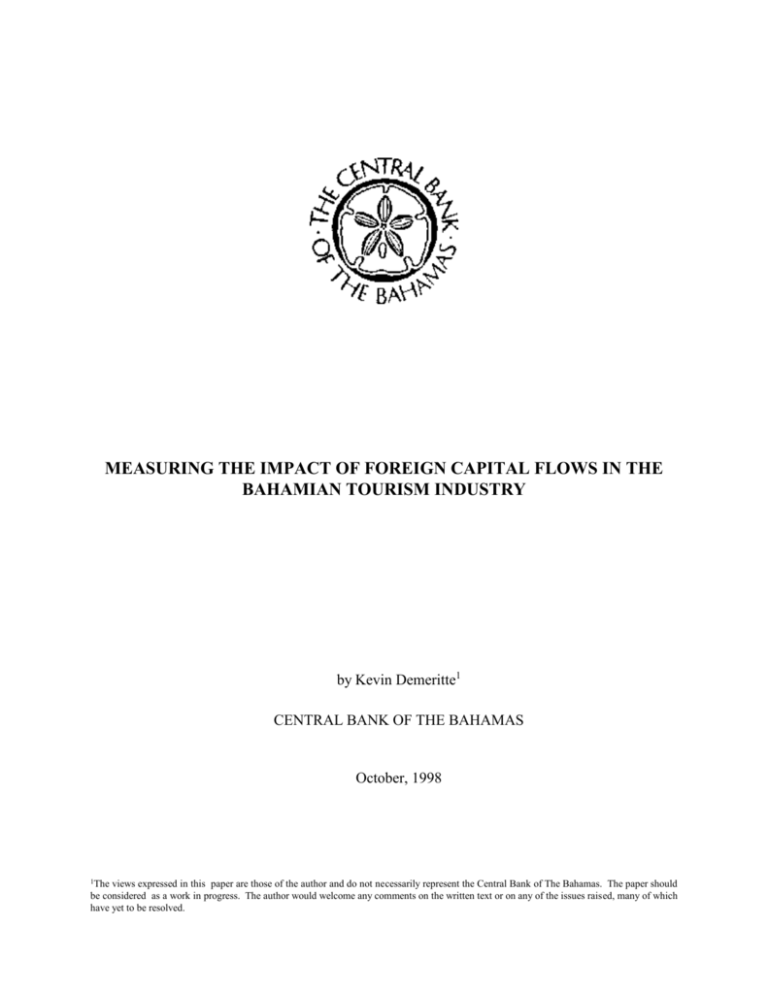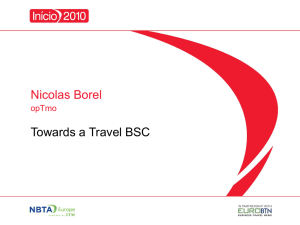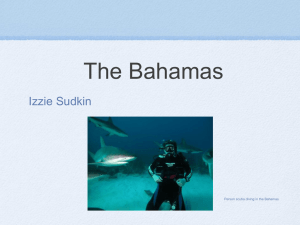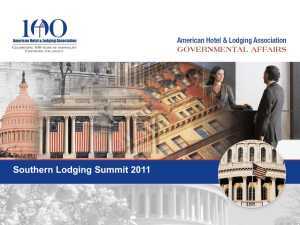Measuring the Impact of Capital Flows
advertisement

MEASURING THE IMPACT OF FOREIGN CAPITAL FLOWS IN THE
BAHAMIAN TOURISM INDUSTRY
by Kevin Demeritte1
CENTRAL BANK OF THE BAHAMAS
October, 1998
1The
views expressed in this paper are those of the author and do not necessarily represent the Central Bank of The Bahamas. The paper should
be considered as a work in progress. The author would welcome any comments on the written text or on any of the issues raised, many of which
have yet to be resolved.
Contents
I.
Introduction
3
II
Foreign Capital Inflows
5
1. Historical Developments
2. Balance of Payments
3. Administration and Regulatory Changes
III
Economic Impact
9
1. Developments in the Tourism Industry
2. Employment
3. Construction
4. Ancillary Services/Products
5. Fiscal Impact
IV.
1. Incentives/Concessions
21
2. Costs/Trade Offs
V.
Conclusion
1. Sustainability of Foreign Capital Inflows
2. Bahamas Experience: Lessons to be Learnt
23
SECTION I
INTRODUCTION:
Notably, there has has been a significant change of direction in the Bahamian economy over
the last five years.
Fiscal policy has been redirected towards infrastructural development,
including schools and clinics, roads, waterworks, port facilities and general physical
environment, and substantial capital, both private and official, has also been invested in
improving the tourism product.
The availability of these resources has been due in large measure to not only sound
macroeconomic policies, but also to a strong rebound in foreign capital inflows from the lull
experienced in previous periods. These inflows have been predominantly from private overseas
sources, with significant concentration of investments in the tourism and industrial sectors. This
private-to-private flow in the form of foreign direct investment (FDI), has provided increased
levels of transfer of technology and management skills, enhanced access to external market
financing of the industrial sector; improved competitiveness and efficiency within the tourism
sector; and expanded employment opportunities.
The influx of external savings into the local tourism industry has been a welcome addition to
the local capital stock, especially in the wake of government decision to withdraw from
ownership of hotel properties, thus freeing substantial capital resources for other budgetary
projects. However, increased links to the external sector by such a dominant industry invariably
exposes the economy more readily to external shocks, while non-Bahamian ownership of
significant proportion of The Bahamas most important sector gives some concern.
In Section II of the paper, the author briefly reviews the historical development of foreign
capital inflows in the Bahamian economy, and discusses the macroeconomic situation of The
Bahamas prior to the period under review. An attempt will then be made to trace the actual level
of foreign capital flows to the tourism industry before highlighting administrative and regulatory
changes that have encouraged increased capital inflows over the past half-decade.
Section III then explores the real impact of these capital flows on the Bahamian economy
from the perspective of employment and the associated impact on the construction industry, as
well as the benefits derived from improved access to new technological innovations and
techniques.
Additionally, these new investments will evaluated within the context of key
industry performance indicators such as visitor arrivals, length of stay and average hotel
occupancy.
Further, we will ask the question, is it too soon to begin measuring overall
macroeconomic impact, or should we wait for a more medium-term evaluation?
Foreign investment to the tourism sector benefits from various concessions and incentives.
Section IV will focus on issues relative to the trade-offs between the revenue base and economic
gains and more specifically, the economic costs associated with revenue concessions provided to
the industry.
The question to be explored is whether this loss in revenues is adequately
compensated for by the employment and tourism gains, and a generally improved economic
environment.
SECTION II
4
FOREIGN CAPITAL INFLOWS - HISTORICAL DEVELOPMENTS
Since the early 1960s, private capital flows has always figured significantly in the
development of The Bahamas. Alongside its evolution as an ideal tourist destination, and as a
choice offshore financial sentre, The Bahamas attracted the wealthy elite, who in many cases
regarded the country as an ideal investment opportunity. Hotel, resorts, marinas and other tourist
related facilities have been the primary recipient of foreign direct investment throughout much of
the past three decades, although there has also been substantial investments in the financial
services industry.
Concurrent with business investments, private capital flows into The Bahamas have included
a healthy proportion of investment in second homes and real estate by wealthy individuals in
both the capital, Nassau as well as the Family Islands. However, with increased restriction on
foreign investment in the economy, and with renewed emphasis by the government of the day, on
greater local control over all aspects of the economy, private capital inflows was effectively
curtailed.
Further, emphasis was placed on a policy of “Bahamization”, in which preference was given
to local residents in various aspects of economic development.
Preferential policies and
legislation were enacted, including the very restrictive Immovable Properties Act which,
effectively barred significant levels of capital inflows, or at the very least made it very expensive
and time consuming for foreign investors contemplating investing in The Bahamas.
However, during the 1980s, in addition to government policy in regards to foreign input into
the local economy, the economic situation in The Bahamas was considerably less favorable for
5
the attraction for foreign capital inflows. The international reputation of The Bahamas came
under fire, while concerns regarding drugs and corruption was featured in the media. The 1991
recession only serve to exacerbate an already difficult environment as the decline in the tourism
product, due in large measure to reduced arrivals from North America, forced the postponement
of much needed infrastructural improvements.
FOREIGN CAPITAL INFLOWS AND THE BALANCE OF PAYMENTS
Capital inflows have always been especially important to the economic well-being of the
Bahamian economy. As a small open economy, with a fixed exchange rate regime and an
economy based primarily on the services rather than industrial or agricultural sectors, The
Bahamas has long been dependent on capital inflows to offset persistent large deficits on the
external current account.
A review of the Capital and Financial account of The Bahamas’ Balance of Payments reveals
that foreign capital inflows into The Bahamas over the last 5 years averaged in excess of $140
million a year, accelerating throughout the period before peaking at nearly $210 million in 1996.
Announced inflows for the first six months of 1997 have already approached $100 million. This
is in contrast to the period immediatly prior, in which inflows fell to a low of $38 million in
1990. Further disaggregation indicates that the bulk of these funds was in the form of foreign
direct investment, representing controlling interests in hotel properties. Expenditure of this type
accounted for over 75% of inflows, while the remaining proportion was allocated to renovation,
refurbishment and general infrastructural improvement.
6
Throughout its history, The Bahamas, with minuscule levels of manufacturing, agricultural
or fisheries products for exports has nevertheless been able to support a fixed exchange rate
regime, with its currency, The Bahamian Dollar, at par with the American Dollar. The level of
private capital inflows has always been sufficient to sustain a balance of payments position
without
ever
having
recourse
to
assistance
from
external
agencies.
Table 1. Balance of Payments (B$M)
1989
1990
1991
1992
1993
1994
1995
1996
1997
227.5
110.5
62.2
16.3
32.0
194.8
38.0
4.0
16.1
17.9
267.7
55.1
12.6
12.7
29.8
141.3
72.9
25.0
13.2
34.7
175.1
117.6
40.1
14.0
63.4
181.1
137.2
49.9
9.3
78.0
224.2
170.8
96.7
32.3
41.8
298.6
209.6
88.6
24.3
96.7
81.3 148.8
30.6 69.0
15.7 54.9
6.0
6.6
8.9
7.5
QI
Financial Account
a. Private Capital Inflow
1. Equity
2. Land Purchases
3. Other Private
QII
ADMINISTRATIVE & REGULATORY CHANGES
Beginning near the end of the last decade, major changes were implemented in the country’s
foreign investment policies. Various laws, regulations, policies and incentives were harmonized
and placed under the jurisdiction of a single agency, with responsibility for promoting the
investment opportunities in the country, engendering greater transparency, as well as
streamlining the entire approval process.
The local second home market was once again
available to “non-residents”, incentives were implemented and legislation passed to encourage
private capital flows.
In the last five years, the following macroeconomic, infrastructural and policy changes were
implemented to created an appropriate investment climate.
7
The creation and publication of a National Investment Policy, which sets out the
government’s policies regarding foreign direct investment; lists areas unavailable to
foreign investment; provides details regarding various incentive schemes that can be
utilized to minimize “red tape” and maximize ease of investing; and list agencies, who
can best assist potential investors.
Repeal of the restrictive Immovable Properties Act and enactment of its more
accomodating replacement, The International Persons Landholding Act in 1993, as well
as harmonization of existing legislation to “level the playing field” between local and
foreign investors.
Passage of appropriate legislation to encourage private capital inflows in various aspects
of the local economy, especially tourism, manufacturing and industry
The creation of appropriate investment vehicles, notably International Business
Companies, Limited Liability Companies, Limited Duration Companies and Limited
Partnerships, to facilitate ease of company formation and investment in and from The
Bahamas.
A renewal of the government’s commitment to prudent monetary policies as well as a
fixed exchange rate regime, with the local and American currencies on par.
8
A committment to reestablish prudent fiscal policies, by reducing government deficits
and debt to GDP ratios, streamlining and harmonizing the tariff structure and increased
productivity of the civil sector.
The implementation of policies and strategies to rehabilitate the reputation of the country
in the wake of drug and corruption charges of the past decade.
The introduction of a comprehensive package of measures, both legislative and
administrative, to discourage use of the financial system for illegal activity, especially
money laundering.
Conducting three high level investment promotion tours of the Far East, Europe, Canada
and South America, aimed at attracting additional investments to The Bahamas.
SECTION III
DEVELOPMENTS IN THE TOURISM INDUSTRY
As the mainstay of the Bahamian economy, developments in the tourist sector are always of
paramount importance to the overall economic development of The Bahamas. Recent inflows of
private capital to the tourist sector have resulted in significant improvement to hotel properties.
The Government has sold all but one of its hotel properties which has been renovated and
upgraded to compete with other similar properties on the Cable Beach strip. In addition, every
major hotel property has either been renovated, refurbished or expanded and several have been
sold to new owners who have invested additional capital.
9
Table 2. Tourist Data
Stopover
Cruise
Total Exp
Stay
Days*
Occ-rate
1991
1992
1993
1994
1995
1996
1,427,035
2,019,964
1,192.70
6.3
11,102,782
52.0
1,398,895
2,139,383
1,243.55
6.1
11,123,302
52.0
1,488,680
2,038,798
1,303.99
6.3
11,563,652
57.2
1,516,035
1,805,607
1,332.59
6.3
11,478,763
62.5
1,598,135
1,543,495
1,346.27
6.1
11,389,271
67.5
1,633,105
1,685,668
1,450.05
6.3
12,070,280
70.7
1997 Q1
442,060
574,181
426.36
6.7
3,559,828
76.8
1997 Q2*
310,620
274,492
n/a
6.0
2,152,192
83.0
*(Apr-May)
Table2. Tourist Data
Stopover
1991
1992
1993
1994
1,427,035
1,398,895
1,488,680
1,516,035
Cruise
2,019,964
2,139,383
2,038,798
1,805,607
Total Exp
1,192.70
1,243.55
1,303.99
1,332.59
Stay
6.3
6.1
6.3
6.3
Days*
11,102,782
11,123,302
11,563,652
11,478,763
Occ-rate
52.0
52.0
57.2
62.5
1995
1,598,135
1,543,495
1,346.27
1996
1,633,105
1,685,668
1,450.05
574,181
426.36
6.7
3,559,828
76.8
274,492
n/a
6.0
2,152,192
83.0
1997 Q1
442,060
1997 Q2*
310,620
6.1
11,389,271
6.3
12,070,280
67.5
70.7
*(Apr-May)
The driving force behind this renaissance has been Sun International’s Atlantis Hotel and
Casino. Formerly owned by Resorts International, the Paradise Island property was purchased
for $100 million. Sun immediately initiated a $150 million renovation and refurbishment project
for the hotel, including a state-of-the-art water theme park and the largest outdoor aquarium and
shark environment in the world. A further $450 million was allocated for Phase 2 of the project
currently underway, scheduled to add an additional 1,200 rooms and with a completion date of
mid-1988. More recently, Sun has announced its decision to implement a $250 million Phase 3,
to begin in 1999. In addition to the Resorts properties, Sun also acquired three adjacent hotel
properties on the Island and after completion of all phases, Atlantis is expected to have in excess
of 2,500 first class room and the largest most elaborate resort in the Western Hemisphere, next to
Las Vegas.
Sun International’s investment in The Bahamas, though significant in its own right, was
especially important for other reasons. By its committment, Sun confirmed its confidence in the
long term economic prospects of The Bahamas. Other investors who may have been hesitant
about The Bahamas saw this as a signal that the climate, conditioned by a stable economic and
10
political regime, was conducive to foreign inevstment. Soon, other significant regional and
international investments quickly followed. Sandals Royal Bahamian, Breezes Superclubs, and
Pink Sands Hotel/Island Outpost were key property investments by Caribbean investors in The
Bahamas, in addition to other long term investments in all aspects of the sector.
Table 3 below, highlights investment and developments in the cruise industry as cruise lines
purchase or lease islands or cays for day long stops by their lines.
Table 3. PRIVATE PORTS OF CALL
COMPANY
DISNEY CRUISE
LINES
ISLAND ACQUIRED/
ACQUISITION
TO BE RENAMED
COST
GORDA CAY (ABACO)/
CASTAWAY CAY
$10,000 a year for
5 years (lease)
ACREAGE
COMPLETION
PROJECTED
DATE
EMPLOYMENT
1,000
mid-1998
N/A
396
end-1999
100 during construction
Development Cost - $30.0 million
HOLLAND
AMERICAN LINES
LITTLE SAN SALVADOR/
HALF MOON CAY
Dvelopment Cost-$10.0m
$6.0 million
ROYAL CARIBBEAN
CRUISE LINES
STIRRUP CAY
Long-term agreement with government
PRINCESS CRUISES
PRINCESS CAY
25 after construction
for this Berry Island Cay
Long-term agreement with government
for this Cay on the tip of Eleuthera Isl.
Note: Recent agreement signed by government for an $8 million expansion of
cruise ship berths in Nassau Harbour to accomodate mega ships and cruise liners
Tables 4 and 6 details sales of major hotel properties to foreign investors since 1992, major
construction projects involving foreign capital in the sector and refurbishments and renovations
to similar properties.
11
Table 4. HOTEL SALES
PROPERTY/
PREVIOUS
PRESENT
To Be Renamed
OWNER
OWNER
Mike Gur
Ruffin Group
CORAL WORLD/
SALE PRICE
Undisclosed
Grenada Plc.
Ruffin Group
$21.0 million
Swimming pool, lush gardens for breakfast
& restoration of restaurants
Crystal Palace
HOLIDAY INN/
Develop further into a high-end resort for
guest of the Crystal Palace
Crystal Cay
NASSAU BEACH/
FUTURE PLANS
Ocean Properties
Sun International
$100.0 million
The Oakes Family
RHK Capital
Undisclosed
Casino, water-themed entertainment
Atlantis Hotel
BEST WESTERN
COLONIAL/
ATLANTIS HOTEL
Luxury five-star hotel, with 4 restaurants, 3
cocktail lounges, & meeting rooms
John Morley
Junkanoo Beach
$2.0 million
2,000 seat convention center & new casino
$19.8 million
Upscale yatching & golf resort, residential
Hotel Ltd.
LUCAYAN BEACH HOTEL & RESORT
Hotel Corporation
GRAND BAHAMA BEACH HOTEL &
ATLANTIK BEACH HOTEL
HutchinsonWhampoa
Sun and Sea Resorts
development, a signiture 18-hole championship
Undisclosed
golf course, a multi-million dollar redevelopment
LUCAYAN COUNTRY CLUB
of the surronding area & construction
BAHAMA REEF GOLF COURSE
500 new rooms in addition to existing 1,350
Over the last decade, The Bahamas experienced a loss of competitiveness as an upscale
destination vis-a-vis regional resort destination. This image was repaired following renovations
by the Atlantis Resort and other major resorts in Nassau/Paradise Island, who offering first class
accommodation and service at a premium price.
Despite the fact that almost every major property has been closed at one time or another for
periods ranging from a few months to over a year for renovations, overall arrivals to The
Bahamas has held steady. In addition, tourist days, which is the product of stopovers and length
of stay plus cruise arrivals, has recovered (see table 2 above). In the short term, new resorts are
scheduled to come on stream and formerly closed resorts to be reopened after renovations
12
Table 5. MAJOR CONSTRUCTION PROJECTS IN THE HOTEL SECTOR
HOTEL
ATLANTIS,
PARADISE ISLAND
SANDALS
ROYAL BAHAMIAN
PROPERTY
# OF ADD.
BLDG.
PROJECTED
EST. COM PLETION
OWNERS
ROOM S
COST
EM PLOYM ENT
DATE
Sun International
1,200
$450 million
2,000 during construction
Mid-1998
(Sol Kerzner)
Sandals
2,000 after construction
210
$37.0 million
(Gordon Stew art)
400 during construction
ADDITIONAL FEATURES
Casino, meeting facilities, w ater themed parks
convestion facilities, ocean adventure environment
Dec-97
200 after construction
Honey-moon suites (103), sw imming pool and an
exquisite restaurant offering Japanese and
Italian foods.
BREEZES
SUPERCLUBS
Super Clubs
104
N/A
(John Issa)
180 during construction
Late '98
Sw imming pool, food outlets on the beach
60-80 after construction
25-30 after construction
PARADISE HARBOUR
CLUB
COMFORT SUITES
Hans Peter, Ericka Kugler & 66 apt. unit complex$20.0 million 50-100 during construction Spring '99 Shopping arcade, health spa, tennis courts, and
Taiwanese Investors
108 rooms
High Point Development Ltd.
75
25-30 after construction
$6.0 million
lagoon type sw imming pool
63 during constructionLate '97 or Early '98
Tennis court, sw imming pool, meeting rooms and
20 after constuction
COTTON BAY CLUB*
Eleuthera Properties Ltd.
74
N/A
CRAB CAY, EXUMA*
N/A
N/A
N/A
a large patio deck surrounded by lush gardens
N/A
1998
N/A
N/A
1,500 after construction
BIMINI BAY HOTEL
Capo Group and RAV Bahamas
200
$100.0 million
850 after construction
LUCAYAN BEACH
An upscale yatching enviroment w tih luxurious
condominiums
Late 2002 A luxurty hotel & casino; 300 slip casino and
MARINA AND CASINO
PINK SANDS HOTEL
N/A
residential community
Island Outpost
10 cottages
(Chris Blackw ell)
20 units
Hutchinson Whampoa
HOTEL AND CASINO
500 rooms
$10.0 million
140 during construction
Late '97
An enclosed dining room
Late '98
upscale yachting & golf resort
25 after construction
$120 million
N/A
200 berth marina
* Due to recent signings much infoemation is not available for these projects
The largest development outside of Atlantis is expected to be Hutchinson Whampoa’s
redevelopment Hutchinson Holdings, which invested $88 million in the first phase of a Container
Port Terminal, purchased 50% of the privately owned international airport and acquired
extensive holdings in the port area. This company is expected to upgrade the Lucayan strip into a
resort to rival that of Atlantis.
13
Table 6. HOTEL REFURBISHMENTS/RENOVATIONS
HOTEL NAME
LOCATION
ESTIMATED
COST
CLUB MEDITERRANEAN
San Salvador
$3.3 million
Paradise Is.
$12.0 million (phase 1)
$25.0 million (phase 2)
NASSAU BEACH
Cable Beach
$12.0 million
GRAND BAHAMA
Grand Bahama
$5.0 million
(phase 1)
BEACH HOTEL
Sun International
$114.5 million
Paradise Isl.
$288.1 million (phase 1)
Atlantis, Paradise Isl.
Nassau, N.P.
$1.37 million
Harbour Is, Eleuthera
$5.0 million
Cable Beach, N.P.
$17.6 million
Treasure Cay, Abaco
$1.2 million
Cable Beach, N.P.
$37.6 million
Pink Sands, Eleuthera
$3.5 million
Sandyport, N.P.
$6.4 million
Musha Cay, Exuma
&7.1 million
Crystal Cay Hotel
Silver Cay, N.P.
$2.5 million
Hutchinson Properties
Grand Bahama
$120.0 million
Cable Beach, N.P.
$22.3 million (phase 1)
Caompass Point
Pink Sands
Superclubs Breezes
Lukkai Tropical Forest
Sandals Royal Bahamian
Club Eleuthera
Sandyport Beach Resort
Musha Cay
Nassau Marriott
$7.3 million (phase 2)
Crystal Palace
Nassau Beach Hotel
HOLIDAY INN (Atlantis)
Cable Beach, N.P.
$12.0 million
Paradise Is.
$50.0 million
14
Employment
Outside of the public service, tourism has long been the dominant employer of the Bahamian
workforce.
Department of Statistics data indicate that the tourism sector has consistently
employed in excess of 45% of the local workforce over the past ten years. It is an acknowledged
fact that the government, through the Hotel Corporation, made use of the state-owned hotels to
employ excess numbers of otherwise unskilled workers.
The natural result was severe
overstaffing and continued pressure on potential profits in the state dominated industry.
The government of the day saw its ownership of hotel properties as more than just an
investment vehicle, but as a means to provide well-paying secure jobs for significant levels of
low and medium-skilled workers. In addition to overstaffing at these properties, necessary
maintenance and upkeep was neglected in the face of declining revenues and increased outlays.
Exacerbated by poor service and inadequated facilities, stopover visitors to The Bahamas
stagnated and repeat visitors declined. However, overall arrivals continued to increase as cruise
visitors (who spend on average 1/10th per visit as stopovers) began to account for an increased
percentage of total arrivals.
Therefore by the late 1980s and early 1990s, the general downward trend in the industry was
fixed and reflected in declining market share, reduced levels of return visitors and the loss of a
number of hotel jobs. Not only was sectoral unemployment on the rise but, due to its pivotal
position in the economy, national unemployment also rose significantly. By 1992, national
unemployment was officially pegged at 14.8% however, anecdotal evidence indicate a much
15
higher percentage especially amongst the female population. Further, workers who remained
employed found their work week reduced to as few as two days.
As part of its overall economic policy to enhance the efficiency of the public sector, the
Governor moved to devolve itself of the state-owned hotels. In 1993, a new National Investment
Policy was enunciated, providing both foreign and local investors with a clearly defined
government strategy for the development of the economy in general, and the tourist sector in
particular. These actions provided effective evidence to investors of the authorities resolve to put
in place a friendly investment infrastructure, and heralded a renewed interest in The Bahamas’
hotel industry by foreign private capital.
However, the immediate result of the sale of many of the nation’s premiere state-owned
hotels to foreign investors was a significant negative impact on employment in the hotel sector.
This was a direct result of the temporary closure of properties to allow for necessary renovation,
refurbishment and upgrades to severely rundown facilities, as is evident in the fluctuation in
available hotel rooms. Further, measures were taken to rationalize staffing levels in a number of
hotels. Most of the large hotel properties have completed this stage, with the exception of recent
purchases by the Hutchinson Whampoa Group, of two major hotels in Freeport, Grand Bahama
and the acquisition by Sun International of two further properties including a 500 room hotel on
Paradise Island, which will be renovated following its current use as housing for construction
workers on Sun’s new 1200 room hotel.
While it is expected that following the renovation and refurbishment exercises, employment
levels would rebound, the more immediate results can be felt in the longer work week extending
16
once again to five and six days.
However, properties, especially the larger ones are also
expanding their facilities and offering additional rooms, which are expected to come on line over
the next two to three seasons. Further, in addition to Sun International’s new 1,200 room
expansion currently underway, new properties, including the reopening of long dormant
facilities, and investment previously on hold are expected to contribute to the increased number
of rooms available and subsequent need for additional personnel. Additionally, new positions
have been created, particularly at the Atlantis Hotel and Marine Park for individuals skilled in the
care and maintenance of marine animals and a reef environment.
Not only are these
improvements expected to positively impact employment in the hotel sector, but in the overall
national unemployment. This is in large measure because of the industry central position in the
economy and the linkages with other activities including, restaurant and suppliers, food and
products importers, transportation industry, handicraft and souvenir production and a host of
individuals directly and indirectly connected to the industry.
The final arbiter of this impact is what effect if any it has had on number of visitors,
expenditure per visitor, length of stay, room rates, hotel revenues and estimates of visitor
expenditures. Further, visitor satisfaction, return visitors and hotel occupancy rates are at peak
levels not see in almost a decade.
As an harbinger of future prospects, the impact of private capital in the tourism industry is
evident in the enhanced competitiveness of the industry relative to its regional and international
competitors.
Once again, The Bahamas has regained its reputation as a quality vacation
experience and perhaps the premier warm weather destination in the hemisphere. Current levels
of investment in the sector and the anticipated increase in new players both in the traditional
17
destinations of Nassau/Paradise Island and Freeport and the Family Islands are expected further
entrench the current trends in investment and the benefits derived therefrom.
The increased inflow of private capital to this sector of the tourism industry has also
encouraged, private flows to other aspects of the tourism market, especially Family Island and
marina development. There has also been a proliferation of smaller properties by local investors
catering domestic tourism.
Construction
The most significant non-industry beneficiary of the tremendous private capital inflow in the
hotel sector has been the local construction industry, which is clear judging from statistics over
the past eight years. The boost to this sector has three major components. Firstly, there has been
a considerable boon to local contractors for renovation and refurbishment; upgrading and
modernizing facilities; and the construction of new hotels including transfer of technology and
innovative construction techniques, notably in the construction of Sun International’s Atlantis
Hotel and Marine Theme Park. It is expected that these techniques are expected to be put into
full use on the second and newly announced $200 million third phase of this project.
As hotels upgrade and modernize their facilities, competing properties have also found it
necessary to keep pace in order to maintain market share. This increased demand on the
construction industry, has necessitated the employment of additional personnel in this sector to
meet the needs of the sector. When the demand placed on the industry by increased construction
18
of private homes, including foreign-owned second homes in the more upscale market, is
augmented by a boost in government infrastructural development, incentives are there for the
construction industry to bring in new personnel including a number of unskilled, and previously
unemployable persons. This is expected to effect an general reduction in overall employment
levels in addition to removing a potential source of social disruption and criminal activity
engendered by large amounts of unemployed individuals in the economy.
Table 7. Construction Data
1989
1990
1991
1992
1993
1994
1995
1996
1997
QI.
QII.
Building Permits
Number
Value (B$M)
of which: Residential
Commercial
Public
3,574
331.50
194.93
65.59
70.98
3,062
399.28
181.65
71.92
145.71
3,091
290.77
197.84
68.23
24.70
2,841
236.60
170.68
58.64
7.28
2,365
221.76
161.11
56.04
4.61
2,618
310.68
163.14
144.46
3.08
2,303
259.17
189.12
56.61
13.44
2,307
639.21
528
58.78
573
89.35
191.45
438.83
8.93
36.35
16.63
5.80
42.60
45.24
1.51
1,682
177.64
109.34
29.21
39.09
1,458
334.92
119.31
41.72
173.90
1,256
145.03
111.00
19.54
14.50
1,118
145.38
105.25
39.17
0.92
1,015
121.03
100.77
20.22
0.04
996
175.28
84.86
89.68
0.74
1,040
119.26
100.22
18.15
0.89
1,100
182.24
117.72
64.27
0.25
298
39.82
30.09
9.26
0.47
315
352.42
32.78
319.64
1,192
109.04
1,212
145.73
1,276
124.99
915
162.14
843
129.57
888
185.89
971
109.91
83.85
24.29
0.90
83.83
59.14
2.76
93.13
31.00
0.86
81.64
79.73
0.77
78.89
45.04
5.64
85.35
89.47
11.07
77.66
20.83
11.42
293
44.43
32.88
11.55
277
40.41
36.18
4.00
0.23
Building Starts
Number
Value (B$M)
of which: Residential
Commercial
Public
-
Building Completions
Number
Value (B$M)
of which: Residential
Commercial
Public
1,030
156.62
91.57
63.31
1.75
-
A review of construction activity over the past eight years, especially construction permits,
which are an indication of future activity, show that the industry and the outlook for employment
and revenue appears especially bright as private construction gradually takes the place of
completed projects in the hotel sector
Ancillary Services/Products
19
Improvements in the tourist sector, financed by growth of private capital inflows, has had a
significant impact on many products and services both directly and indirectly related to tourism.
Vendors, including souvenirs vendors, hair braiders, vendors of native straw products and
native arts and crafts, tour companies and taxi and limousine franchisers are all expected to
reap substantial benefits in terms of increased business with the expected boost in tourist
arrivals. One example has been the recent increase in executive limousine imports, which are
used principally to cater to the more affluent tourist clientele.
Reflecting agreements forged by the government, increased linkages are being forged
between local producers of fruits and vegetables and hotel owners and operators for the
increased use of native-locally grown fruits and vegetables.
Increased numbers of employed workers, logging a greater number of hours per week,
naturally translates to increase demand for all products and services in the economy. Overall
unemployment has been reduced from a high of $14.8% in 1992 to an estimated 10.6% last
year. In addition, real GDP growth which fell by as much as 2.7%in 1991 and declined on
average 0.36% over the previous five years, improved by an estimated 3.0% in 1996, and is
expected to increased further in 1997.
Private capital inflows to the tourism sector through the sale of state-owned properties,
contributed significantly to the overall national economic well-being through sale proceeds
being made available to the consolidated account, enabling additional funds to become
available for general purposes including infrastructure development.
20
Further, enhanced macroeconomic environment is reflected in the general downward trend in
interest rate over the last five years and limited fall-off in international reserves despite
increased current deficits.
In addition to being able to sustain a larger current account deficit on the balance of payments
and increased international reserves, redevelopments in the tourism industry are expected to
have resulted in increased ability of the part of the fiscal authorities to increased its debt
service ratio, retire outstanding domestic public sector loans and reduce government’s
contingent liabilities.
SECTION IV
INCENTIVES/CONCESSIONS
Several pieces of legisltion have been enacted or updated to encourage foreign investment in the
tourism sector, including The Hotels Encouragement Act, and the Tariff Act. Exemptions and
concessions are often granted on a discretionary basis but have included:-
The right of investors to acquire publicly owned lands for approved
developments on concessionary terms.
Exemption from the payment of customs duties on building materials,
equipment and approved raw materials.
Exemption, reduction and/or postponement of business license fees and real
property taxes for periods up to twenty years.
21
Certain exemptions from imigration provisions may also be made available,
allowing permits for key personnel.
Exemptions, from various fees and taxes are often granted for developers of
small touristic properties in the Family Islands.
Apart from exemptions granted under certain programs and initiatives,
discretionary exemptions are often available such as a reduction in casion
taxes.
The incentives, many of which are listed above which are available to foreign investors can
also be enjoyed by local investors in targeted industries especially tourism. Table 10 at the end of
the paper lists some of the local investors who have taken advantage of concessions and
incentives under the Hotel Encouragement Act to construct small hotels, guest houses and fishing
“villages” throughout The Bahamas.
COSTS/TRADE-OFFS
However, the economic costs associated with the granting of these concessions/incentives
and legislative initiatives, not to foreign but also local investors in the tourism industry, is
expected to continue to be felt in the local economy over both the medium and long-term in
terms of lost revenues and the consequent reduction in the ability of the government to continue
to provide the level os goods and services previously expected.
22
Some social costs predicated on the above-mentioned iniatives include significant
adjustment by hotel employees, as well as the unions that represent them. A new understanding
must be forged between workers and employers regarding working environment and on the job
expectations, which may be considerably different than previous. The realization that many hotel
workers can no longer expect to retain their previous positions and renumeration levels, without
increased productivity may exact a human cost in terms of job-related anxiety and its associated
ills. As well as the acceptance that unlike previous state-owned hotel properties, these facilities
would now be owned and operated by individuals whose primary interest would not be the
maximization of employment but profits.
There is also the cost associated with having such a large proportion of the factors of
production of the tourism industry concentrated in non-Bahamian hands. Lost of control over this
very vital industry and concerns that the national destiny will be determined by other not native
and perhaps not sympathetic to national needs and overall national development goals.
SECTION V
CONCLUSION:
SUATAINABILITY OF FOREIGN CAPITAL INFLOWS
A critical question for The Bahamas as we review the impact of this surge in capital inflows
is: to what extent will internal and external developments combine to make the flow endure? Part
of the answer to this question depends on the continuation of underlying trends in the
international financial sector--that is, the globalization of markets and industries and the
diversification of portfolios. The growing interest of regional and international investors in The
23
Bahamas could continue throughout the rest of the 1990s in the form of large-scale investment
including investments in the hotel sector. The movement of international capital into The
Bahamas has been based as much on government policy, legislative initiatives and economic
growth, as on the assumption of high expected returns.
However, we can ill afford to rest on our achievements to date.
Our regional and
international competitors, viewing the success of the Bahamian model are likely to emulate this
model in terms of addressing infrastructural constraints, which may have limited the
attractiveness of these territories to international investors. Sustainability and durability also
depend on internal conditions. The Bahamas must continue to implement sound macroeconomic
policies, maintain a strong commitment to market oriented reform, and outward oriented services
industries and strategies, likely to enhance the credibility of the country’s policy makers from the
stand point of international investors.
Notwithstanding the role of foreign investors, however, further efforts and policies are
needed to promote increased domestic savings and adequate returns on domestic investment in
the small and mid-sized hotel properties.
The Bahamas Experience: Lessons to be Learnt?
International standards for market infrastructure provided an excellent medium-term
benchmark for The Bahamas and indeed the rest of the Caribbean. We as a region may need to
continue to emulate the experience of the more advanced emerging markets, especially those in
24
Asia, which substantially improve market infrastructure in a relatively short period by
leapfrogging to state-of-the-art systems.
Investors however, remain concerned with the unreliability of emerging markets in three
main areas: market infrastructure (where the consequences include high transaction costs,
frequent delays in settlement, and outright failed traded); protection of property rights, in
particular those of minority shareholders; and disclosure of market and company information and
control of abusive market practices. These are the areas that we all need to focus on in order the
attract and maintain levels of foreign capital inflow enabling ourselves to achieve increased
levels of growth and development. Unfortunately, there are no simple solutions to preparing
capital markets for financial integration, which requires concentrated action across a broad array
of areas to improve market infrastructure and the regulatory framework.
This experience, however, together with the not infrequent weakness characteristic of
emerging market financial intermediaries, also suggest two cautionary notes:- First, improving
the speed of project approvals for FDI as well as portfolio investments should not be achieved at
the expense of the overall economic development plans of the nation. Second, despite the
importance of improving investor confidence, appropriate standards of conduct, employee
relations, industrial safety and workers rights should not be relegated to an afterthought.
A model for the regulation of foreign private inflows as envisioned for The Bahamas’
tourism sector and applicable for overall capital market development, is based on the principles
of disclosure and self-regulation currently gaining wide acceptance in emerging markets because
of its strong advantages over direct government industry involvement.
25
But government
regulation and oversight are still essential, and the state can play a crucial role in capital market
as well as touristic development, in partnership with the private sector, providing the basic legal
structures, for example, and fostering vital market institutions. Given the weaknesses in the
regulatory systems of many emerging markets in our region and the susceptibility to “reputational
risk,” the trade-off between market development and effective regulation required to develop and
maintain market confidence is less pronounced than is sometimes thought.
Private capital flows has indeed been a boon to the Bahamian economy in general and the
Bahamas’ tourism industry in particular and it is expected that with close cooperation between
foreign investors, the local private sector and the regulatory authorities, we can continue to reap
the benefits of this inflow in a prudent and productive manner over the medium and long-term. It
is clear that there is inherent dangers to the local economy and national autonomy over a
significant portion of the economic capacity of the country, however, at least as at the present
time, The Bahamas has pointed the way in which other territories can attract and benefit from
international capital flows.
26
THE BAHAMAS: MACROECONOMIC INDICATORS
1.
Nominal GDP Growth Rate
Real GDP Growth Rate
2/
3/
Nominal GDP
Real GDP
2.
1/
1991
1992
1993
1994
1995
(3.5)
0.1
(0.6)
3.1
2.3
1996 1997 Q1
5.1
N/A
(2.7)
3,101.2
(2.0)
3,103.48
1.7
3,085.2
0.9
3,180.8
0.3
3,254.0
3
3,420.0
N/A
N/A
2,800.4
2,744.4
2,791.0
2,816.1
2,824.6
2,909.3
N/A
7.1
5.7
2.7
1.3
2.2
1.5
1.1
Retail Price Index (Oct/Nov 1995=100)
90.3
93.7
96.3
97.6
99.7
101.1
101.3
3.
Wage Indices
N/A
N/A
N/A
N/A
N/A
N/A
n/a
4
Unemployment Rate
12.3
14.8
13.1
13.3
11.1
10.6e
n/a
5.
Fiscal Accounts B$MN
(14.5)
(0.5)
(113.7)
(3.7)
490.4
15.8
523.7
16.9
88.1
2.8
2.6
0.1
(88.1)
(2.8)
534.6
17.2
530.6
17.1
92.1
3.0
3.7
0.1
(85.1)
(2.8)
537.1
17.4
533.4
17.3
88.8
2.9
63.0
2.0
(20.0)
(0.6)
618.2
19.4
551.6
17.3
86.6
2.7
60.9
1.9
(23.2)
(0.7)
651.2
20.0
586.2
18.0
97.2
3.0
32.9
1.0
(64.7)
(1.9)
678.9
19.9
645.7
18.9
97.8
2.9
2.9
N/A
(34.7)
N/A
179.4
N/A
176.5
N/A
37.6
N/A
Interest Rates (%)
Prime Lending Rate
3 months Time Deposit Rate
Weighted Average Loan Rate
9.00
7.1
15.35
8.00
6.1
15.33
7.25
5.2
14.88
6.75
4.5
14.22
6.75
4.6
13.26
6.75
5.1
12.56
6.75
5.0
13.04
Int'l Reserves B$ MN:
Gross Reserves
Changes in Reserves
Import Cover Ratio (weeks)
173.8
14.3
8.4
146.0
(27.8)
7.0
164.3
18.3
7.9
173.6
9.3
8.4
170.6
(3.0)
8.2
163.0
(7.6)
7.9
221.3
58.3
10.7
8.
Monetary Base
207.0
201.0
199.4
223.5
232.0
227.2
244.2
9.
B$/US$: Exchange Rate
End of Period
High
Low
1.0
1.0
1.0
1.0
1.0
1.0
1.0
1.0
1.0
1.0
1.0
1.0
1.0
1.0
1.0
1.0
1.0
1.0
1.0
1.0
1.0
10. Balance of Payments B$ MN:
Current Balance
Current Balance % of GDP
Capital & Financial Balance
Capital & Financial Balance % of GDP
(179.4)
(5.8)
169.5
5.5
37.5
1.2
(7.8)
(0.3)
70.5
2.3
(0.1)
(0.0)
(18.6)
(0.6)
62.6
2.0
(128.5)
(4.0)
90.7
2.8
(205.0)
(6.0)
130.8
3.8
47.8
N/A
23.3
N/A
11. Total Public Sector Debt B$ MN.
1,309.1
1,426.8
1,537.9
1,579.5
1,583.3
1,636.0
1,646.0
342.1
967.0
412.3
377.6
1,049.2
440.5
359.7
1,178.2
453.4
332.3
1,247.2
410.4
304.6
1,278.7
393.4
283.8
1,352.2
357.8
273.7
1,372.3
347.9
4.6%
42.2
13.3%
4.9%
46.0
14.2%
5.0%
49.8
14.7%
5.6%
49.7
12.9%
5.0%
48.7
12.1%
5.2%
47.8
10.5%
6.9%
N/A
N/A
896.8
986.3
1,084.5
1,169.0
1,190.1
1,277.5
1,298.9
141.2
755.6
135.0
851.3
131.0
953.5
126.6
1,042.4
126.7
1,063.4
127.9
1,149.6
129.3
1,169.6
13. Tourism
Stopover Arrivals ('000s)
Cruise Arrivals ('000s)
Total Arrivals ('000s)
Tourist Expenditure (B$m)
1,427.0
2,020.0
3,622.2
1,192.7
1,398.9
2,140.5
3,690.6
1,243.6
1,488.7
2,038.8
3,672.3
1,304.0
1,516.0
1,805.6
3,447.5
1,332.6
1,598.1
1,543.5
3,239.2
1,346.3
1,633.1
1,685.6
3,415.8
1,450.0
442.1
574.2
1,349.3
426.4
14. Construction
Number of Permits Issued
3,091
2,841
2,365
2,618
2,303
2,307
Inflation Rate (Average chg in RPI)
Current Balance
Current Balance % of GDP
Overall Balance
Overall Balance % of GDP
Current Revenues
Current Revenue % of GDP
Current Expenditure
Current Expenditure % of GDP
Capital Expenditure
Capital Expenditure % of GDP
6.
7.
of which: External
Internal
(foreign currency debt)
Debt Service Ratio
Total Debt/GDP
External debt/GDP
12. Domestic Public Sector Debt: B$MN
Loans
Securities
3
Value of Starts (B$'000s)
145.0
145.3
121
175.3
119.3
186.8
Value of Completion's (B$'000s )
125.0
162.1
129.6
185.9
109.9
156.6
e=estimate
# 5. Jan. June (1996) = five months through May
27
1/ With the exception of public sector debt data, projections are those prepared by the IMF during the 1995 Article IV visit..
2/ Data for 1991-1993 are official estimates; data for 1994 onwards are IMF GDP estimates.
3/ There are no official estimates for real GDP, estimates are those of the IMF.
528
39.8
44.4
REFERENCES
Archer, Brian: The Impact of Domestic Tourism, Bangor Occasional Papers in Economic,
General Editor: Jack Revel, 1973 University of Wales Press.
Archer, Brian: Tourism in The Bahamas, The Impact of The Tourism Dollar, Institute of
Economic Research, University College of North Wales, UK 1976
Archer, Brian: Employment and Tourism in The Bahamas, Institute of Economic Research,
University College of North Wales, UK, 1977
Archer, Brian: The Tourist Dollar, Its Impact on Incomes and Employment in The Bahamas,
Institute of Economic Research, University College of North Wales, UK, 1981
Bahamas Investment Authority: Various Reports
Bahamas Ministry of Tourism: Statistical Reports
Central Bank of The Bahamas: Quarterly Statistical Digests
28







